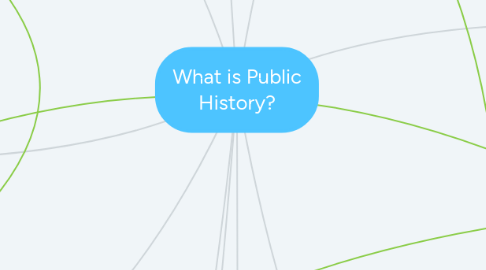
1. Public
1.1. Audience
1.1.1. The goal is to present information in a way that is meaningful and informative to the general public, as apposed to academia.
1.1.2. Stakeholders
1.1.2.1. People who personally are influenced by the project. i.e. those who are members of a group being represented.
1.2. Non-academics--- People who do not choose history as their profession.
2. Authority
2.1. Who has the authority to determine history?
2.1.1. The Public? Or Historians?
2.2. Each person has their own history, defined by their own understanding and memory of the events in their life.
3. Bias
3.1. Reliability
3.1.1. How do you determine if a source is reliable?
3.1.1.1. Ask questions about who the source is from, when it was written, and what outside influences it may have. In other words, examine its biases
3.1.2. Objectivity
3.1.2.1. Objectivity allows for the exhamination of the data from multiple angles. Full objectivity is impossible as bias is always carried.
3.2. Our understanding of the past is influenced by many different biases.
3.3. What is represent? What is left out? What viewpoints are not being examined?
4. Collaboration
4.1. Historians must work together with the public to reach common ground without relinquishing too much expertise.
4.2. Making exhibits requires a large team, as discussed with the "NC Green Book Project." Not only do Historians collaborate among themselves, but with the public as well to garner information and examine their work.
4.2.1. Green Books Guest Lecture
5. Archives/Collections
5.1. Our memory of the past, and therefore our history that is extrapolated is affected by what is collected
5.2. What we collect and remember from the past is not the entire story, instead just shreds of what people remember and wrote down.
5.3. "Embracing the Power of Archives" Jimerson
6. Civic Dialogue
6.1. An important aspect of public history is the ability to inspire conversation about the issues that the public has faced in the past and in turn promote discussion about current issues.
6.1.1. How do we have dialogue?
6.1.1.1. One way is to provide spaces where people are educated about issues and then are presented with discussion, like the immigrant museum in "Kitchen Conversations."
6.2. "Kitchen Conversations" Abram
7. History
7.1. The study of the past using the historical method to make inferences and form beliefs about what we believe to have happened.
7.1.1. What is the Historical Method?
7.1.1.1. The thought process, based on the scientific method, that historians use to examine data/artifacts and make arguments based on them.
7.1.1.2. "Thinking Historically" Lyon et. al.
7.2. The story told based on an incomplete knowledge of events of the past.
7.2.1. Why is it incomplete?
8. Memory
8.1. Public Memory
8.1.1. Influenced by many things from personal experience to nostalgia and museums.
8.1.2. Museums
8.1.2.1. Influences the memory of the public through curated exhibits and shows of artifacts.
8.1.2.2. Museums show bias because they exhibit what the curators find important, thus showing only their belief. Therefor it is important for public historians to include the stakeholders in exhibit creation.
8.1.3. "The Civil Rights Movement in American Memory" Romano and Raiford
8.2. Memory is how we understand the past. Where history is the accepted viewpoint overall, each individuals memory is valid in that it is their own personal understanding.
8.2.1. Can Memory be Wrong?
8.2.1.1. Memory can be wrong, as some statements can be proven factually incorrect. However, some things are less concrete and thus leave more room for interpretation. The balance between this authority is an area of debate in public history.

